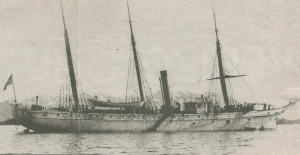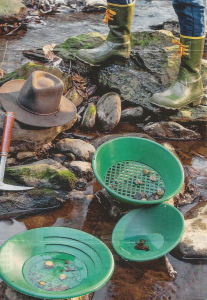Gold on the Clara Nevada: Cold Case Gets Hot
The cat’s out of the bag. All bets are off. I’m letting the chips fall where they may. Or perhaps I should say I’m letting the gold fall into the hands of divers who have the determination and tenacity to discover it. I’m not trying to start an Alaskan gold rush, but when you hear the “Clara Nevada” story you might be tempted to pack your gear and head for the Klondike.
Never heard of it? Neither had I until I read an intriguing article, The Mystery of the Clara Nevada in the Baltimore Sun. It gave an engaging account of the 1896 gold rush in Canada and Alaska that drew thousands of hopefuls through the “Gateway to the Klondike,” the portals that opened in Portland and Seattle where some of the miners chose the overland route. But most preferred the faster sea passage, and utilized every local vessel available.
As she aged, the Clara Nevada wasn’t the most seaworthy ship afloat. Christened the Hassler in 1872 and placed in the U.S. Coast and Geodetic Service, it plied Alaskan waters for 25 years. When the McGuire brothers of the Pacific and Alaska Transportation Company bought it in 1897, they frugally refitted the ship and hired low wage seamen to sail it between Oregon and Washington. Often over-loaded with livestock, the ship took a beating in heavy seas. She wasn’t a good candidate for animals, much less mankind. But that didn’t deter the brothers, whose cheaply refitted steamer became part of the gold rush “Fleet of Greed.”
Captained by Charles H. Lewis of Baltimore, Maryland, the three-masted steamer was heading south from the Skagway gold fields in February, 1898, when she ran into a fierce storm. A witness reported seeing an orange fireball in the night sky and a ship that disappeared off Eldred Rock in Lynn Canal about 30 miles south of Skagway. Only one body was found in the wreckage that washed ashore. The passenger list was lost, but it’s believed that at least 60 and perhaps more than 100 passengers and crew were aboard. It appears the storm drove the ship out of the deep canal and on to a submerged pinnacle. After breaking up and drifting, its remains were scattered off the rocky shoreline in 10 to 30 feet of water.
News of the sinking spread quickly. So did the buzz about purported bags of gold dust and nuggets aboard worth about $165,000 (valued at $14 million today). Further grapevine chatter included thieves who set dynamite charges to cover up their robbery. Other conjectures had the crew drinking and fighting; illegal explosives purportedly stored below; and claims that the hole divers later discovered in the side of the ship was from a blast, not the result of a rocky collision. The main shaft, prop and boiler were salvaged in the early 1900s, but the gold was never recovered. The ship’s bow points north, its machinery, hull plates and deck fittings scattered over the rocks for several hundred yards.
In 1907, a statuesque lighthouse dedicated to the Clara Nevada was built just south of the wreck site. During construction, workers claimed they saw a ghost ship at dusk far out in the canal near the sea pinnacle. The apparition was never seen again after the lighthouse was completed.
Other mysterious accounts can be found in a captivating book: The Clara Nevada—Gold, Greed, Murder and Alaska’s Inside Passage by Steven C. Levi.
16 Comments
Submit a Comment
All Rights Reserved © | National Underwater and Marine Agency
All Rights Reserved © | National Underwater and Marine Agency
Web Design by Floyd Dog Design
Web Design by Floyd Dog Design




Great article Professor, That story sounds just like the PSS Pacific in 1875.
Hi Ethan: Good to hear from you. Yes, it does sound like the Pacific. I want to try and get the book about the Clara Nevada. It has some interestng twists and turns. Stay in touch!
What an interesting story about the Clara Nevada. After reading it, I found the book online and ordered it: The Clara Nevada: Gold, Greed, Murder and Alaska’s Inside Passage. I can’t wait to read it. Thanks for writing about it!
Thanks for your nice comment. Oh yes, good, I’m glad you will get the book. The story has many twists and turns. Let me know how you like it and if you want me to recommend the book to others.
Prof. Boyd, I managed to get my hands on a copy of “The German Secret Service in America 1914 to 1918…” and it says that when the SMS Dresden sank in Cumberland Bay in Juan Fernandez, she was carrying a hoard of gold. Has NUMA ever looked at the wreck to confirm the legend? If so, then I hope that somebody who is not in it for the money salvages it.
Thanks for the tip. I am not familiar with this one–maybe vaguely remember reading about it years ago, but forgot about it. I will check in my book about Juan Fernandez and see what it says. I will tell Dirk Cussler about it if it seems feasible to search for it, for its historical value not treasure. Thanks again!
Been a fan of Clive Cussler since his first publication, followed a link to the NUMA site and discovered so many interesting topics by you, many thanks for opening a new window of information to my never ending thirst of underwater discoveries, now I know what I’ll be doing over the long winter months here.
My great grandfather had always thought his eldest son went down on the ill fated Clara Nevada.
What happened to the Captain he later showed up in census report!
I don’t know what happened to the captain, Charles Lewis of Baltimore. I did not get the book, The Clara Nevada: Gold, Greed, Murder and Alaska’s Inside Passage. It MIGHT give us a clue.
My great grandfather Robert Bruce Banks lost his life on the Clara Nevada
I’m so sorry for your loss. Have you gone back through research of he disaster and through your family history to learn more about your grandfather and the ship’s sad ending? I would be interested if you have more information.
There is an article about Robert Bruce Banks on the National Parks site about the Clara Nevada.
My grandfather’s half-brother was a crewman on the Clara Nevada and is listed in the newspaper articles about those who were lost.
Many thanks, I’ll look that article up. That’s interesting about your grandfather’s half-brother. I’ve heard from one other person who lost a relative on the Clara Nevada. Things pop up now and then about this shipwreck. It still holds a lot of interest.
I have original letters from Robert Bruce Banks to his family and their letters to him during this time. The letters never reached him but were returned to the family.
Thanks for your input. I’m sure these letters hold much sentimental value. And, another way to look at them, they keep the story—sad as it may be—of the Clara Nevada alive. It is gone but not forgotten.